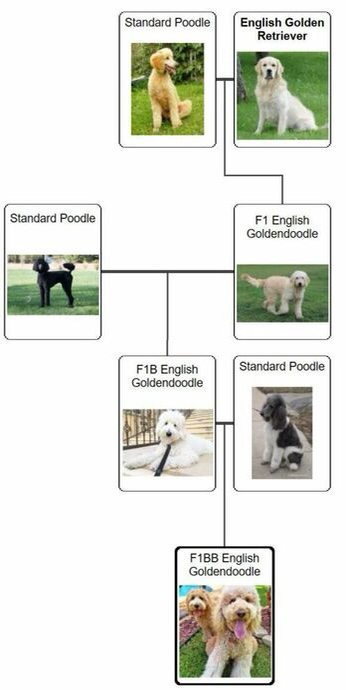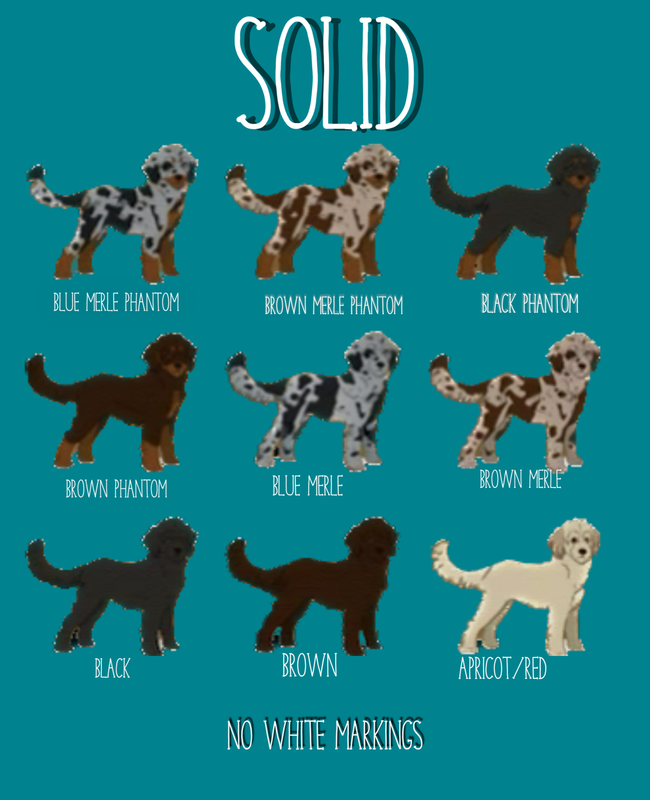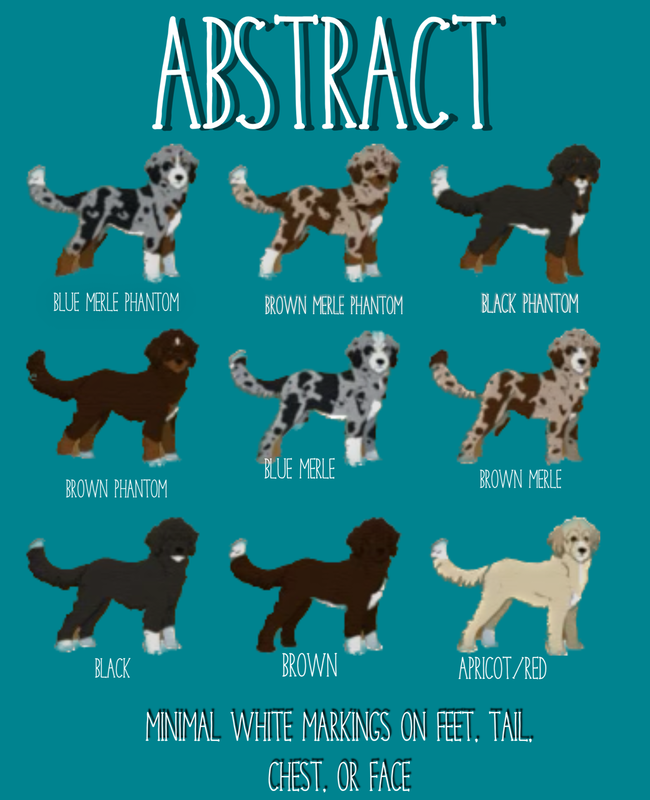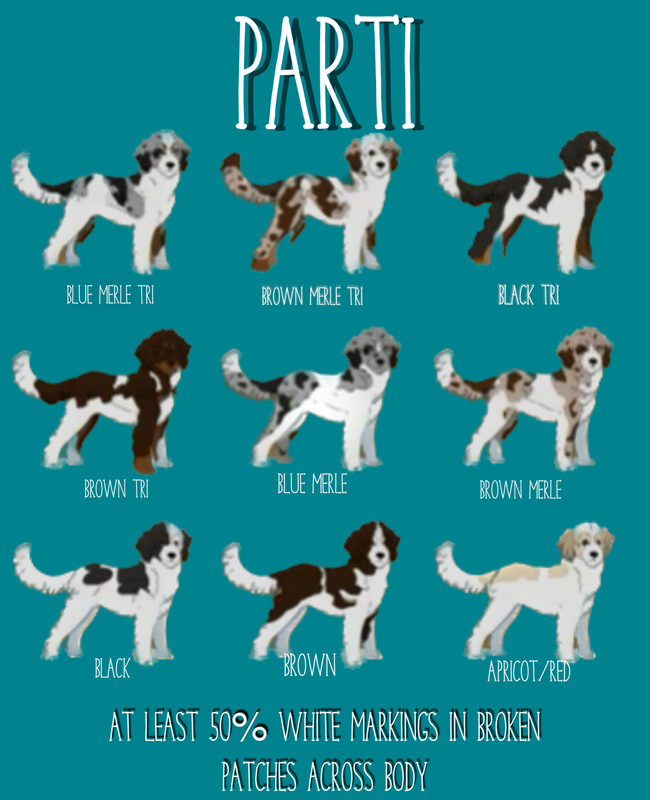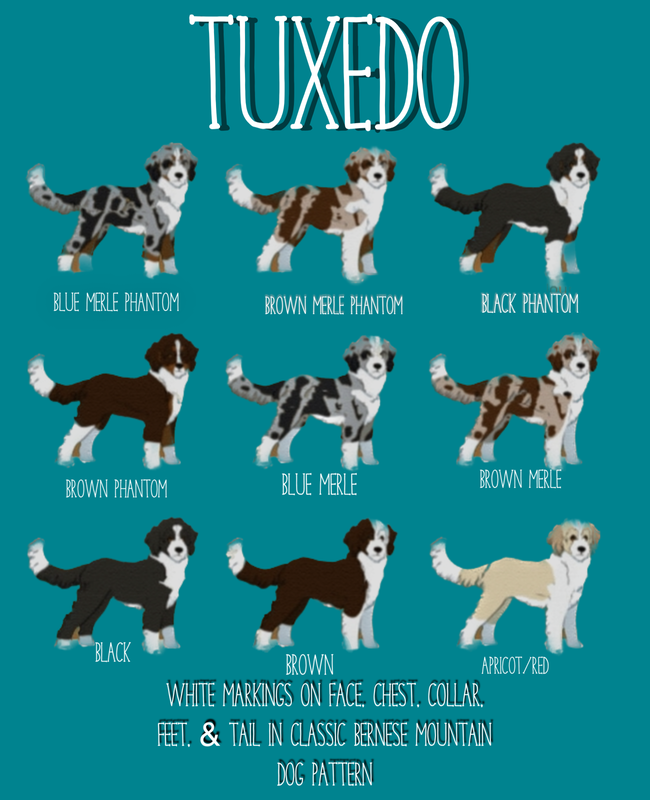In general, the further you move down the tree, the higher percentage of the doodle is poodle. This means that the dog is more likely to have poodle like hair, be nonshedding, and need regular grooming.
But please remember that genetics can be random and sometimes puppies will take on the dominant traits of either Poodle, Golden Retriever, or Labrador no matter what label of generation. We have had super curly coats and flat coats come from lines that surprised us even after reviewing DNA tests. Below are some family trees explaining the generations and photos comparing different coats we have seen.
But please remember that genetics can be random and sometimes puppies will take on the dominant traits of either Poodle, Golden Retriever, or Labrador no matter what label of generation. We have had super curly coats and flat coats come from lines that surprised us even after reviewing DNA tests. Below are some family trees explaining the generations and photos comparing different coats we have seen.
F1 Generation Explained
An F1 Goldendoodle is a cross between a pure bred Standard Poodle and a pure bred Golden Retriever.
An F1 Labradoodle is a cross between a pure bred Standard Poodle and a pure bred Labrador retriever.
Most first generation vary with shedding (some more than others) but most shed at least minimally.
F1B Generation Explained
An F1B Goldendoodle is produced by crossing a F1 Goldendoodle with a Poodle. F1B Goldendoodles will have a higher success rate for non-shedding, and are recommended for families with moderate to severe allergies.
An F1B Labradoodle is produced by crossing a F1 Labradoodle with a Poodle. These again are recommend for families with allergies looking for higher chance of success with no shedding.
F1BB Generation Explained
There are also some breeders who produce a F1BB cross. That would be a F1B crossed with a Standard Poodle. These Goldendoodles and Labradoodles will most likely have a lot of curl and be great with families that have moderate to severe allergies. Certain coat DNA/genetics will determine further how these puppies coats will turn out. Some breeders do not call them F1bb, but will label them F1b or “multi-gen” – all is fine as there is no real standard labeling, but if you are concerned about allergy or looks, then ask what generation the parents are.
F2 and F2B Generations
The second generation Goldendoodle (F2) is produced by crossing a F1 Goldendoodle with a F1 Goldendoodle. This results in half Retriever and half poodle once again. The F2B generation Goldendoodle is a cross between a F1 Goldendoodle and a F1B Goldendoodle. The same concept applies for Labradoodles. The F2B will have a higher success rate for non-shedding and are recommended for families with moderate to severe allergies.
An F1 Goldendoodle is a cross between a pure bred Standard Poodle and a pure bred Golden Retriever.
An F1 Labradoodle is a cross between a pure bred Standard Poodle and a pure bred Labrador retriever.
Most first generation vary with shedding (some more than others) but most shed at least minimally.
F1B Generation Explained
An F1B Goldendoodle is produced by crossing a F1 Goldendoodle with a Poodle. F1B Goldendoodles will have a higher success rate for non-shedding, and are recommended for families with moderate to severe allergies.
An F1B Labradoodle is produced by crossing a F1 Labradoodle with a Poodle. These again are recommend for families with allergies looking for higher chance of success with no shedding.
F1BB Generation Explained
There are also some breeders who produce a F1BB cross. That would be a F1B crossed with a Standard Poodle. These Goldendoodles and Labradoodles will most likely have a lot of curl and be great with families that have moderate to severe allergies. Certain coat DNA/genetics will determine further how these puppies coats will turn out. Some breeders do not call them F1bb, but will label them F1b or “multi-gen” – all is fine as there is no real standard labeling, but if you are concerned about allergy or looks, then ask what generation the parents are.
F2 and F2B Generations
The second generation Goldendoodle (F2) is produced by crossing a F1 Goldendoodle with a F1 Goldendoodle. This results in half Retriever and half poodle once again. The F2B generation Goldendoodle is a cross between a F1 Goldendoodle and a F1B Goldendoodle. The same concept applies for Labradoodles. The F2B will have a higher success rate for non-shedding and are recommended for families with moderate to severe allergies.
